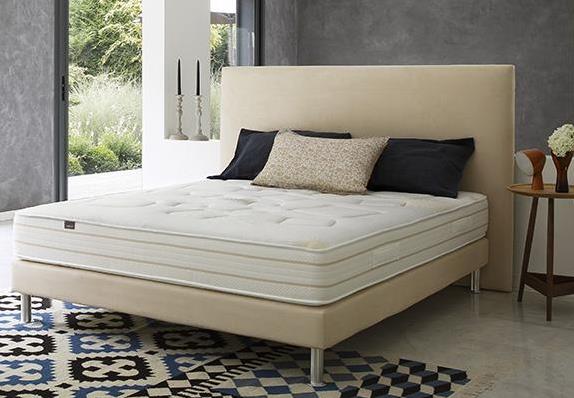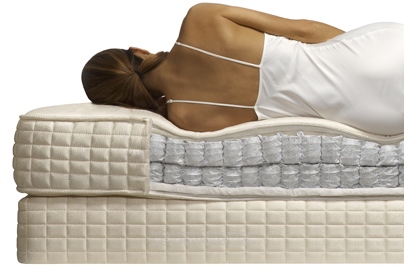Your guide to shopping
- Details
- PRACTICAL PRACTICAL
- ➤ SHOPPING HOW-TO SHOPPING HOW-TO
- Published: 24 March 2016 24 March 2016
Mattresses play an important role when it comes to sleep quality, and buying a new one can quickly become a real pain! There are so many variables to take into account: a bed for one or for a couple, the morphology of the sleepers, the personal preference for a soft or hard surface… For every individual there is a right mattress. It’s also important to determine whether you’ll be using the bed, or if it will be exclusively for Airbnb & co guests. Then comes the criteria by which you’ll be making your choice: the type, the firmness, the stuffing and hygiene. Purchasing guide…
 © Matelas Treca, Grand Litier
© Matelas Treca, Grand Litier
1. The Type
The first thing to consider when buying a mattress is the type of mattress that’s right for you. This is what the mattress is made of, and determines the quality of support you’ll be getting. There are three main types of mattresses on the market these days: foam, latex and innerspring. Though it’s difficult to give advice on this topic since it comes down to personal taste, let’s do an overview of their principal characteristics…
 © DR
© DR
Foam Mattresses
Foam mattresses are traditionally considered to be low-end mattresses for consumers. And wrongly so. Originally made of chemicals, foam is now going green and becoming more and more natural. There are also different quality mattresses in polyether, polyurethane and memory foam.
- Polyether
Foam mattresses made of polyether are made of closed-cell foam, and the density varies from 10 to 15 lb/ft3. These are generally low end mattresses, that are firm but have a short lifespan if they’re used daily. If you don’t host too many guests or if you’re buying it for kids, they could be the right fit for your rental.
Pro: Very affordable prices
Cons: limited use, medium comfort, wears down
- Polyurethane
Foam mattresses made of polyurethane are made of open-cell foam. They have more elasticity than polyether mattresses and have a density over 15 lb/ft3. The higher the density, the more comfortable and resistant the mattress will be. Mattress density can go up to 40 lb/ft3.
Pros: both firm and soft, light, good ventilation (recommended for those with allergies), durable
Con: not good for humid spaces
- Memory Foam
Also referred to as viscoelastic foam, memory foam mattresses are high end. They adapt perfectly to the sleeper’s morphology and limit pressure points on the body, providing you with an incredibly comfortable sleep. This foam has a very high density, from 34 to 57 lb/ft3, the disadvantage being that it’s affected by temperature. In a cool space the mattress will harden, making it much firmer. Also, if you or your travellers perspire a lot, the mattress will soften and act as a mold, retaining heat within the mattress.
Pros: recommended for those with back, joint and blood circulation problems, absorbs movement
Cons: expensive, temperature sensitive
 © Neorev
© Neorev
Latex Mattresses
Latex mattresses are highly regarded because they’re equipped with differentiated comfort zones from 3 to 10 (5 being very comfortable already). Soft to the touch but firm, these mattresses are not easily worn down. They provide great support and absorb movement. They’re very breathable making them perfect for people who perspire heavily and for humid interiors. The mattress’ density varies from 50 to 57 lb/ft3 (a density above 60 lb/ft3 could be uncomfortable), and the quality increases with the thickness of the latex block, which ranges from 5 to 8 inches (try not to go below 5.5).
Pros: breathable, comfortable, durable, hypoallergenic, absorbs movement
Cons: expensive (price depends on the number of comfort zones, the density and the thickness)
Innerspring Mattresses
The quality of the mattress will depend on the type and quantity of springs. As the number of springs increases so does comfort and support.
- Conical Springs
Also called Bonnell coils, these springs (240 to 350 for a 55 x 75 in mattress) have for a long time been the most commonly used. Firm, maybe too firm, they offer medium movement absorption. Many professionals have abandoned this low end mattress because of its short lifespan and clients have complained that the coils dig into their backs.
Cons: short lifespan, uncomfortable
- Continuous Coils
This type of mattress (600 to 3000 coils for a 55 x 75 in mattress) is formed from a single piece of wire, so you’re sleeping on a single spring. Because of this, there is very little movement absorption, making it a bad choice for couples. Keep in mind that sleepers roll over 40 times per night on average!
Pros: sturdiness, breathable, firm support
Cons: no movement absorption
- Pocket Springs
These springs work independently ensuring that every part of your body is properly supported. They mold perfectly to your body’s morphology and offer incredible comfort for your spine and lower back. You can also easily move around without waking your partner. Pocket springs are currently the leading technology for this type of mattress. The springs (400 to 1200 for a 55 x 75 in mattress) are encased in fabric pockets that increase breathability making it a good mattress for sleepers that transpire heavily.
Pros: movement absorption, breathable, durable, good for large builds
Cons: expensive
 © Simmons
© Simmons
2. Hardeness
The hardness (soft to firm) depends on the mattress density (measured in pound per cubic foot). For foam and latex mattresses, the higher the density, the firmer the mattress. For innerspring mattresses, the higher the number of springs, the more the mattress zones are differentiated, offering more tailored comfort.
A mattress for you and your guests
Think of your comfort first, choosing a firmness that fits your height and weight. Test the mattress in store. If, when you’re lying down on your back, your hand fits between your lower back and the mattress, then the model is too firm. If you find it difficult to go from the dorsal position to the lateral position or if your elbow sinks into the mattress when you turn over, the mattress is too soft. In short, a good mattress has to be firm enough to support your body and soft enough to conform to your body.
A mattress exclusively for your guests
If the mattress is only for travellers renting your place, opt for a slightly firm mattress that will fit most people. If the mattress is too firm, it will irritate pressure points, causing bad circulation, back pain and stiff muscles. On the other hand, if a mattress is too soft, the thorax and the lower back sink in, causing the spine to curve.
3. The Stuffing
The stuffing determines the comfort level and good quality stuffing is essential to avoid a sunk-in mattress. Made of wool, silk, cotton, linen or cashmere, its designed to offer a soft surface and is completely compatible with firm or very firm mattresses. The ticking, the protective fabric used to encase mattresses, offers softness, but you should also ensure that the anti-dust-mite or anti-mold treatments that it may have undergone are natural and non-chemical.
4. Hygiene
If you host guests often, be sure to keep the mattress hygienic. The ultimate tool to ensure cleanliness is a removable antiperspirant upholstery layer. You can also opt for a hypoallergenic mattress, but remember that airing it out, keeping the room at a cool temperature, washing the bed sheets at 60° and vacuuming the mattress once a week are all good habits to limit the spread of bacteria.
Conclusion
You now have all the information needed to choose a mattress that will give your guests the restful sleep they need to contribute to their overall well-being. But remember that even the best mattress on top of a misshapen bed base won’t do any good! For more detailed information about the 9 factors to consider when choosing a mattress, according to sience, you can visit Jen Reviews.
|
How to choose a mattress for your sofa bed? If you have to update the mattress of your convertible sofa, first determine whether it will be used regularly or only occasionally. If you host guests often, opt for a 5.5 inch thickness and a minimum density of 17 lb/ft3 for polyurethane foam or 40 lb/ft3 for latex foam and with 682 springs for pocket spring mattresses. |

